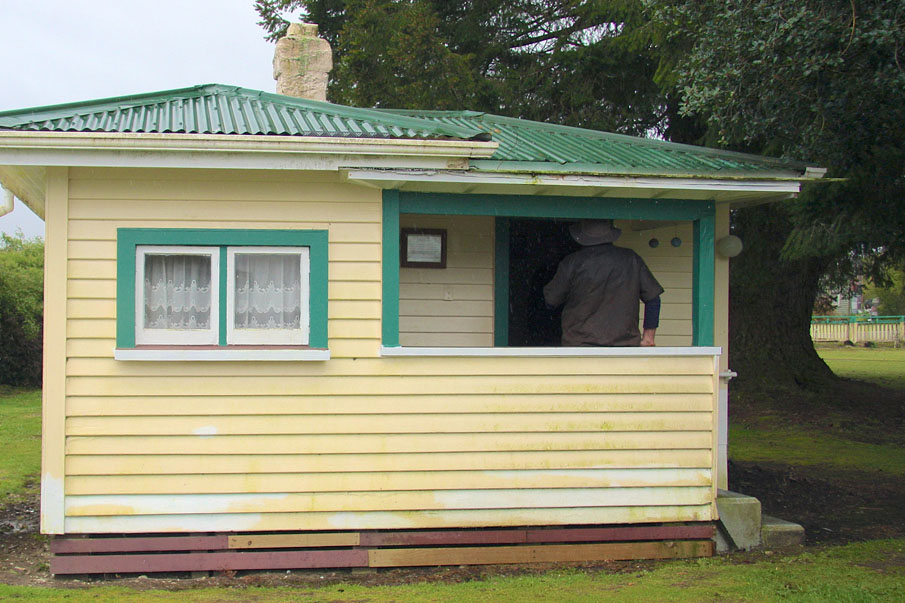This place is part of an historic area that was registered under the Historic Places Act 1993. The following text is from the original Historic Area Assessment Under Section 23 Criteria report considered by the NZHPT Board at the time of registration of the historic area. Model Bungalow. The Model Bungalow, built 1938-40, relates comfortably in technical and design terms with a set of contemporary ideas, both social and architectural, which broke new ground in the housing design and construction field in new Zealand in the late 1930s. It drew on certain established architectural precedents that were coming into fashion here in the late 1930s, e.g., International Modernism and standard house design and materials, but remarkably, the place is, as far as anyone knows, the only example of a school project by Primary School aged pupils that set out to design and build a complete, contemporary, model house. The rarity value of the building on this score would have to be seen as being exceptional. Other examples of a model bungalow like this are non-existent and if one were looking for examples to compare it with, the nearest parallel one could make is with the first State Houses produced by the Department of Housing Construction of the first Labour Government after 1937. The style of the Model Bungalow and that of the first State Houses is approximately the same, essentially fitting into the English Cottage style with (as Peter Shaw comments) an oblique reference to Modernism. There is of course no known connection between State Housing ideas and the Model bungalow at Kotuku and it would be misleading to suggest, even on a comparative basis, that there was. The extraordinary fact is however, that somehow a twelve and a half year old girl, Rosemary O'Brien, managed to put into her design all of the ideas that were in the minds of private architects like Swan & Lavalle, Horace Massey, and the England Brothers, who at precisely that point in time were submitting their first open plan English Cottage style State Housing designs to the D.H.C. A cursory examination of the standard 1930s house features embodied in Rosemary O'Brien's design, e.g., the standard joinery, window casements, architraves and doors, and the modem 'Cubo-eclectic' interior decoration, makes this fact seem a little less extraordinary although it doesn't alter the fact that she was working in isolation on the remote West Coast, did not have any major contact with an architect - except where Darracott mentions that a Christchurch architect assisted them later on, apparently with the design of the bathroom - and that the ideas she had for a model home were new in 1938 and were only just being accepted by more advanced architects in New Zealand. Perhaps this begs the question as to what extent Darracott himself had influence over the final design. It must have been there in some degree although he doesn't say so in his report and modestly gives all the credit to the children. Still, one is tempted to think that if Darracott was a radical in the education field, he must have known about Modernism in the architectural and fine arts field. One can only guess the photograph he took of the 7' x 6' carpet square which the children designed (still surviving in the Canterbury College of Education) shows a Modernist abstract design of surprisingly high quality. In summary, the Model Bungalow project, as an exercise in practical education, was conceived in terms of designing a model, ideal home of the 1930s. In achieving this objective the finished building in fact represented a modem, quasi-standard style of cottage architecture which was coming into vogue at the time and which became embodied in the first state houses of the first Labour Government. In keeping with this style, the Model Bungalow incorporated contemporary ideas concerning the use of standard joinery and, in a limited sense, ideas of open planning, all of which were relatively new at the time (1938) but which characterised a "modern" home.


Location
List Entry Information
Overview
Detailed List Entry
Status
Listed
List Entry Status
Historic Place Category 1
Access
Private/No Public Access
List Number
7232
Date Entered
7th July 1995
Date of Effect
7th July 1995
City/District Council
Grey District
Region
West Coast Region
Extent of List Entry
Extent includes part of the land described as RES 698 (NZ Gazette 2004 p 2336, RT WS8A/559), Westland Land District and the building known as Model Bungalow thereon. (Refer to the extent map tabled at the Heritage List/Rārangi Kōrero Committee meeting on 8 October 2015.)
Legal description
RES 698 (NZ Gazette 2004 p 2336, RT WS8A/559), Westland Land District
Related listings
Stay up to date with Heritage this month
